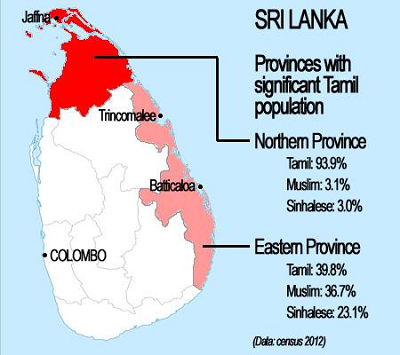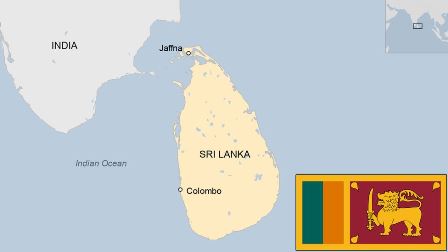Context
What is the Tamil Issue and its History?
- Background: Sri Lanka's population is 74.9% Sinhalese and 11.2% Sri Lankan Tamil. The Sinhalese are primarily Buddhist, while Tamils are mainly Hindu, reflecting significant linguistic and religious divisions. The Tamils are believed to have arrived from India’s Chola Kingdom as invaders and traders. Historically, tensions between Sinhalese and Tamils stem from power disputes rather than cultural incompatibility.
- Pre-Civil War: During British rule, Tamils were favored, leaving the Sinhalese feeling marginalized. After gaining independence in 1948, Sinhalese-dominated governments passed laws disenfranchising Tamils, leading to the creation of the Liberation Tigers of Tamil Eelam (LTTE) in 1976. Inspired by Che Guevara's guerrilla tactics, the LTTE's actions escalated into civil war in 1983, with significant violence targeting Tamils in Colombo. The war lasted nearly three decades, ending in May 2009 with the death of the LTTE leader.
- Post-Civil War: Despite the war's end in 2009, many Tamils remain displaced, and issues persist. The government's Prevention of Terrorism Act (PTA) disproportionately targets Tamils, and "Sinhalization" efforts have replaced Tamil culture with Sinhalese culture in predominantly Tamil areas. This includes the proliferation of Sinhalese monuments, road signs, and Buddhist places of worship, erasing Tamil and Hindu cultural elements and historical perspectives.
- Recent Crises: As some rural communities began to recover, Sri Lanka faced new turmoil. The 2019 Easter bombings, the COVID-19 pandemic, and a severe economic crisis, the worst since Independence, have derailed progress. For those emerging from war, the current crises threaten to derail another generation’s prospects.
Polarisation and the Minorities
Rajapaksa Regime's Influence: The Rajapaksa regime bears significant responsibility for the post-war trajectory in the North and East, marked by jingoistic war victory celebrations, continued militarization, and the projection of Sinhala Buddhist nationalism. Unfortunately, Tamil nationalist politics mirrors this polarization, sustaining itself through divisive discourse.

Tamil Nationalist Politics
Tamil politics remains fixated on LTTE rhetoric, victimhood, and reliance on the international community. Regular appeals to the UN Human Rights Council by political actors and sections of the diaspora foster unrealistic hopes of international intervention, without addressing local issues.
- Lack of Reconciliation Efforts: Political actors from both the South and North have failed to build social and economic bridges for reconciliation. Efforts towards devolution and power-sharing have been repeatedly abandoned for political gain, as seen in the lost opportunity for a settlement during the 2015 regime change. Ongoing land seizures from Tamil and Muslim minorities and attacks on war memorials further hinder reconciliation.
- Failure of the Northern Provincial Council: The Northern Provincial Council, elected in 2013, ended in disgrace in 2018, failing to deliver any significant political or economic vision. The ineffectiveness of Tamil leadership and the arrogance of Colombo's political elite continue to plague Sri Lankan politics.
- Inter-Community Relations:Tamil-Muslim relations remain strained, with Northern Muslims, expelled by the LTTE in 1990, still struggling for reintegration. Malaiyaha Tamils, displaced from the plantations, found little support in the North and remain largely landless. Caste oppression in Jaffna is reemerging, fueled by diaspora-funded temples and some groups' Hindutva-styled mobilizations.
|
What are the Concerns for India? ● Rehabilitation of Refugees: Many Sri Lankan Tamils who fled the 2009 civil war are seeking refuge in Tamil Nadu. Fearing persecution, they are reluctant to return, posing a challenge for India in their rehabilitation. ● Sentiments of Indian Tamils: The Indian government faces protests and criticism for neglecting the plight of Sri Lankan Tamils to maintain good relations with Sri Lanka. This issue is particularly sensitive among Indian Tamils. ● Strategic Interests vs. Tamil Question: India often has to balance Tamil minority rights with strategic interests. Protecting economic interests in the region and countering Chinese influence in the Indian Ocean sometimes requires compromising on Tamilian rights. |
Future of the Tamil People
- Current State and Prospects: Six decades later, the Tamil people's situation has worsened, and Tamil politics has descended further. The future depends on rejecting failed Tamil nationalism and forging a new vision for both themselves and the country.
- Lessons from the Aragalaya: The 2022 Aragalaya, where diverse Sri Lankans united to oust a President who symbolized Sinhala-Buddhist nationalism, offers inspiration for a unified, just future for Sri Lanka.
Conclusion
The future of the Tamil people is dependent on forging a new vision for themselves and the entire country, based on equality and freedom. Only through a concerted effort to bridge ethnic and social divides, focus on economic empowerment, and embrace a collective national identity can Sri Lanka move beyond its painful past towards a prosperous future. It is in Sri Lanka’s best interests to work towards empowerment of people , for which devolution of power (13th Amendment of the Sri Lankan Constitution) to the grassroots level is a pre-requisite.
|
Probable Questions for UPSC Mains Exam-
|
Source- The Hindu







